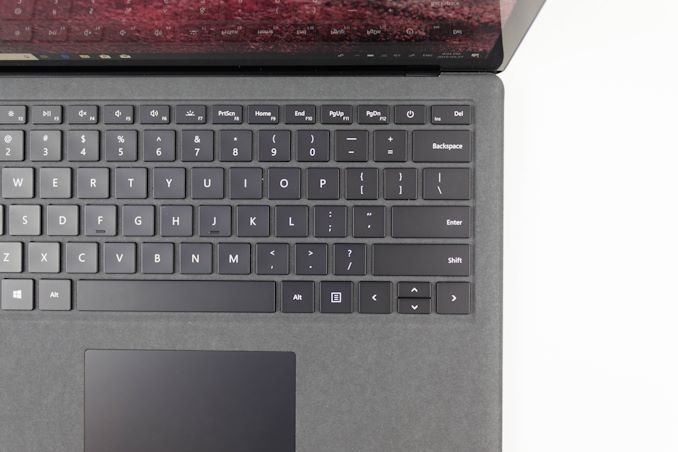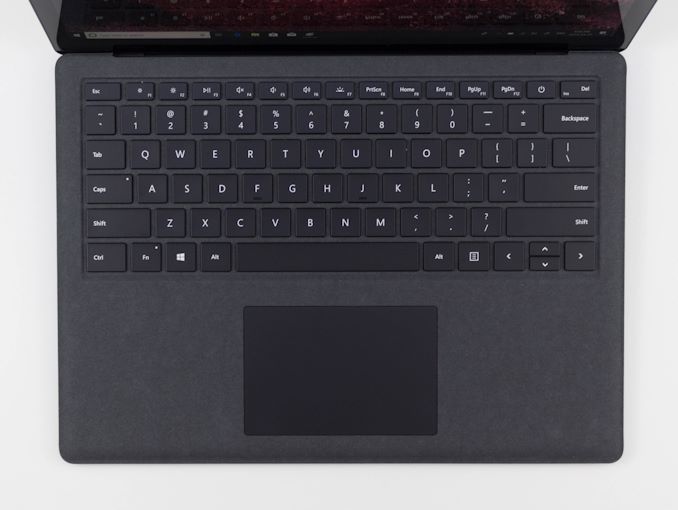The Microsoft Surface Laptop 2 Review: Surface Essentials
by Brett Howse on March 28, 2019 8:00 AM EST- Posted in
- Laptops
- Microsoft
- Surface
- Surface Laptop
- KBL-R
- Surface Laptop 2
Design
By forgoing the convertible nature of the rest of the Surface lineup, the Surface Laptop doesn’t offer the wow factor that the other models do. But for those that are after the pure laptop experience, they also don’t get any of the drawbacks of those designs either. Surface Laptop 2 is just a pure laptop. Thin, light, and offering almost 12% more display area than an equivalent 13.3-inch 16:9 laptop, the Surface Laptop should allow a lot of productivity without sacrificing portability.
The Surface Laptop 2 is built out of aluminum, unlike the magnesium alloy used in Surface Pro and Surface Book. Meanwhile the exterior colors of Burgundy, Platinum, Cobalt Blue, or the Black featured on the review unit allow the customer to choose a laptop color to suit their tastes a bit more than most manufacturers who offer one, or sometimes two color options. The edges are sharp and the finish is smooth, and although taste is subjective, the Surface Laptop is a stunner. Microsoft continues to impress with their device build quality and design.
Opening up the device takes just a single finger, which is one of the advantages of going with a pure laptop over a convertible model. The display bezels aren’t the smallest on the market, but are small enough that it still feels like the 3:2 display fills the entire area, while still providing room for the Windows Hello IR camera, ambient light sensor, and 720p front facing webcam in its correct location. The extra vertical height helps with the proportions of the device too, since it doesn’t have to have a large chin on the bottom, or be a very squat design.
One of the main design features for the Surface Laptop 2 is the Alcantara keyboard deck, and it is color-matched to the outside of the device. The fabric isn’t quite the same texture as a Surface Pro keyboard either, offering a smoother finish, while still feeling great when used. There may be concerns about durability over time, but as a synthetic fabric it holds up well and can be cleaned if needed. The fabric deck is a great contrast to the cool, smooth aluminum used elsewhere.
Microsoft generally offers a great keyboard experience, and the Surface Laptop 2 is no exception. The keys feel great to use. There’s just enough travel and resistance to provide you with good feedback, and is really one of the best keyboards on a thin and light laptop. There are also three levels of white backlighting, and unlike some manufacturers who get this wrong, the backlighting wakes up when using the trackpad, so even in a dark room you can find your keys easily.
Speaking of the trackpad, Microsoft pretty much offers the best trackpad experience of any Windows PC. There are others that equal it, but none that really surpass it. The trackpad is very smooth glass, and responds well to taps or gestures. The extra vertical height of the 3:2 display also allows for a slightly larger trackpad than a 16:9 laptop would. The extra space on the vertical doesn’t get in the way either like some of the wider trackpads do. It’s of course adjustable with Microsoft’s Precision trackpad drivers, so you can adjust it right in Windows.
The Surface Connect port is located on the right side of the laptop, and is where the magnetic Surface Connect charging cable goes. Microsoft also sells a Surface Dock that can connect here, and which provides two display outputs along with extra USB and Ethernet. But be warned that the Surface Dock can’t run two UHD displays at 60 Hz. The Surface Connect port really needs a refresh at this point, since it is showing its age. Most Surface users probably appreciate the magnetic charging connection, but it is time for a spec bump.
Meanwhile the single USB Type-A port is located on the left side, along with the Mini DisplayPort and 3.5 mm headset jack. Although this amount of expansion is definitely on the light side, for many this should be plenty, and the color-matched accessories such as the Surface Mobile Mouse connect over Bluetooth anyway. Even so, it would have been nice to see Microsoft mimic the Surface Book 2 here and just replace the Mini DisplayPort with USB-C, since it would double the expansion, allow for charging, and there really isn’t a downside. It’s hard to argue with them that the Type-A port is still required, but it is 2019 and not having any USB Type-C is just not acceptable anymore on a premium device such as this.
Still, despite that obvious flaw, the overall design of the Surface Laptop 2 is excellent. It feels good to carry around. It feels great to use. The Windows Hello camera is fast and accurate, and makes you miss it the second you use a device without it. Microsoft continues to deliver on chassis, keyboard, and trackpad quality across their lineup. There’s no wow factor like a Surface Book’s detachable display, but the benefit is you get a much tighter, lighter package.














59 Comments
View All Comments
sorten - Thursday, March 28, 2019 - link
If I absolutely needed a laptop today I'd probably pick up a used one so I could wait for the Ice Lake CPUs from Intel this fall. It would be a shame to buy such nice hardware only to find yourself two significant generations behind within 6 months.yankeeDDL - Thursday, March 28, 2019 - link
I hope you're right. Intel has been caught sleeping, and the improvements since SkyLake have been, frankly, anecdotal. It seems that AMD, by making a small core, designed from the ground up to work in tandem with other cores, has a much more effective/scalable architecture. So a 4-core, 8-thread CPU from AMD, while providing slightly lower IPC, today, is much more effective than a 4-core, 8-thread CPU from Intel.Let's see if ICL brings real benefits. The 10nm node should help a lot.
smilingcrow - Thursday, March 28, 2019 - link
"So a 4-core, 8-thread CPU from AMD, while providing slightly lower IPC, today, is much more effective than a 4-core, 8-thread CPU from Intel."I thought AMD currently has lower IPC + lower clock speeds so how exactly are they more effective?
With Ryzen3/Zen 2 due in the summer this may change but for now AMDs advantage is more cores per buck.
niva - Thursday, March 28, 2019 - link
I'm assuming he meant in terms of price/core, but that's just a guess.Doesn't AMD have a big problem with power consumption in mobile CPUs though? I've read that the AMD laptops out now suffer from big power drain even if performance wise they're equivalent or batter than the Intel chips at the same price range.
Irata - Friday, March 29, 2019 - link
Supposedly in idle only, but I do not really see that on my Matebook. Then again, I do not let it sit idling for hours on battery since it boots so quickly that there is no reason for that.In normal use (web / video), the battery indicator does not move much at all.
What many forget is that even with Intel based laptops, there are sometimes big differences between models or manufacturer, depending on the battery size and how well they configured their laptop. The ones that aren't well done are not the ones you usually see in comparison tests though (as there are more models to pick from vs. AMD based ones).
lightningz71 - Monday, April 1, 2019 - link
Their big problem was definitely low power states management on the 2X00u series of chips. The 3x00 series chips that are now hitting the market make up a lot of ground in that regard, both with the chips themselves and better bios/uefi implementations by the vendors that are building the systems. Add in the fact that AMD has finally decided to take the lead on providing a stable, performant drivers for the video section of the chips, and you can largely ignore the abysmal efforts of the vendors themselves to provide quality, updated drivers themselves.For the money, some of the low end AMD 2x00u series laptops gave you MUCH more bang for your buck than the equivalent intel based offerings. The few limitations that people who purchased them did come across could be overcome through software tools by those that it actually mattered to (power and performance management profiles could be tweaked by certain software tools that allowed systems to maintain higher boost states longer and better manage their thermals).
I can't wait to see some of the more thorough write-ups on the latest 3x00h series laptops that are fast enough in both core performance and graphics performance to go up against comparable intel based machines that also include an Nvidia MX1xx series dGPU with an i5. They should technically be less expensive, offer similar performance and be more power friendly when pushed to their limits. This isn't to say that they won't have their flaws, just that, dollar for dollar, on the low end, you'll get more with the AMD system.
Manch - Friday, March 29, 2019 - link
Superior SMTsmilingcrow - Friday, March 29, 2019 - link
IPC includes the whole chip performance so they are still behind.Zen currently makes sense to me if you want 8 or more cores so hopefully with Zen 2 they will compete from 4 cores upwards.
Manch - Monday, April 1, 2019 - link
IPC refers to the perf of a single core usually. Generally has an advantage of about 8-10%. That advantage disapears when using SMT/HT. AMD has the more efficient design so it makes up for that 10% deficit. Throw in multiple core and it starts to win. TBS even now a lot of software is optimized still for Intel but thats changing rapidly. Intel still has a clockspeed advantage. Where as Zen has a pretty hard wall @4.3, Intel can get on down the road a good bit faster. Especially with 4 core chips. I dont think that advantage will last too much longer. Between the mitigations from ME/SPec, and lack of new architecture, Intel seem to be pushing cores over HT now to keep its advantage short term. AMD put out a competitive chip, Intel has yet to fire back like it did with Core against Athlon XPs(Those were the days!) Theyre just stretching their long in the tooth Core. Something is waiting in the wings though.smilingcrow - Monday, April 1, 2019 - link
From what I've seen a 6C/12T Intel beats a similar spec AMD easily.I've read that AMD's HT gives a bigger boost than Intel's but that still isn't enough for it to catch up due to it being too far behind in other areas.
So it's about as meaningful in the real world as a purely synthetic benchmark.
That should change soon with Zen 2 so there will be no need to live the life of a fantasist then.